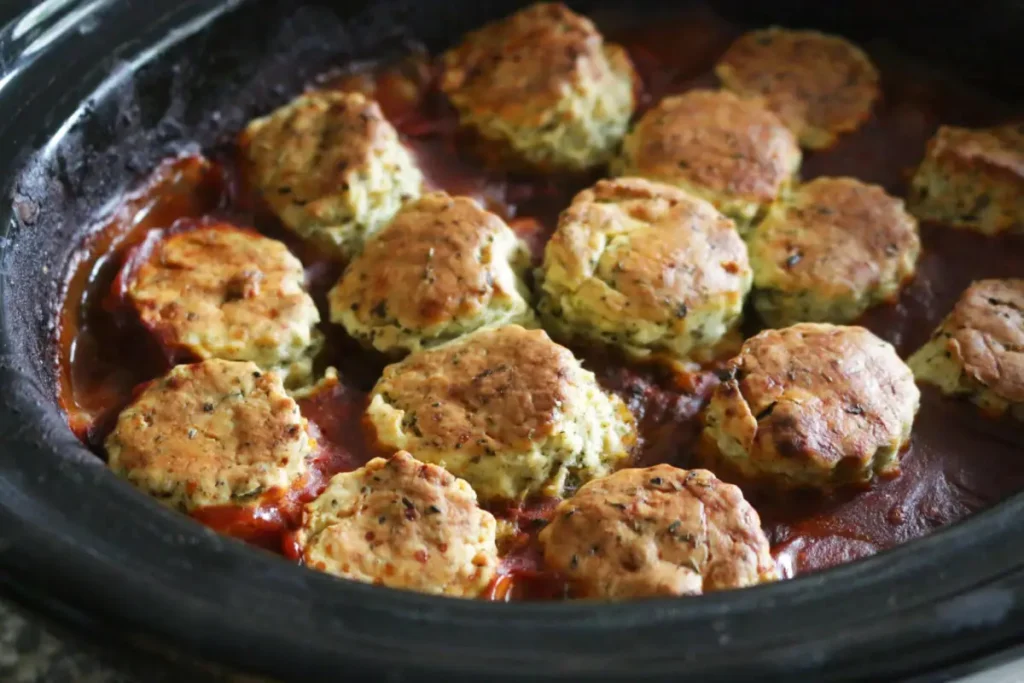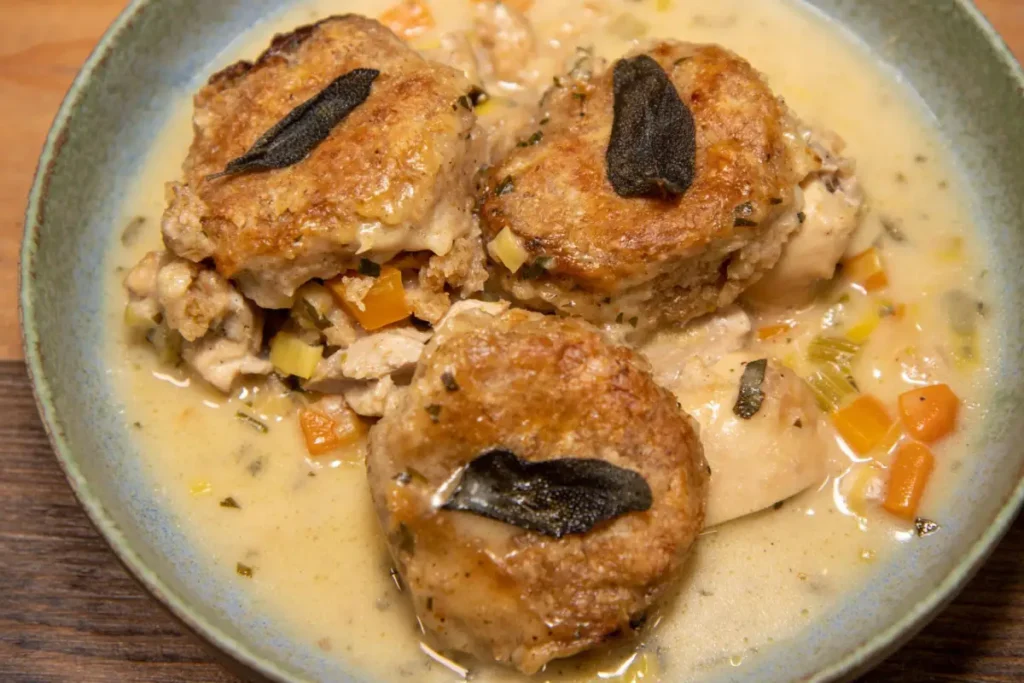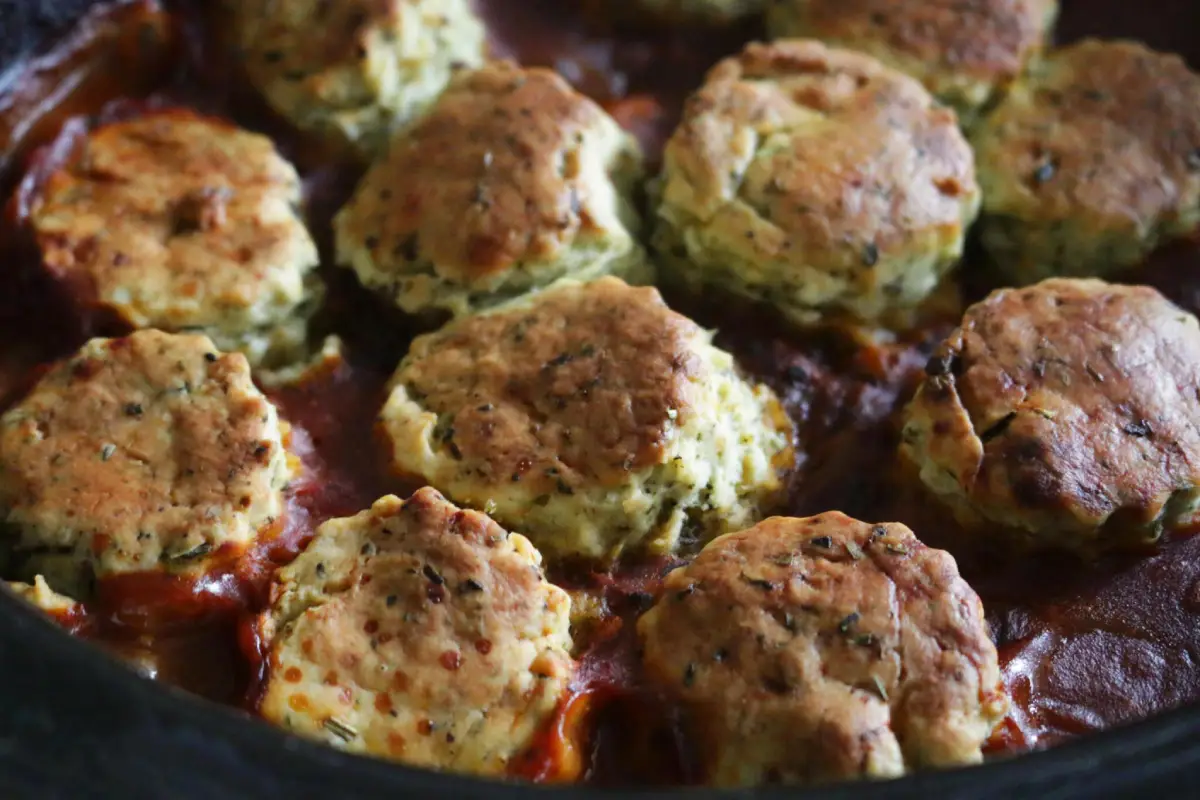Nestled in the heart of comfort food menus, the chicken cobbler stands as a testament to homely, hearty meals that bring warmth and satisfaction to any table. This dish, with its tender, flavorful chicken and golden, fluffy topping, evokes memories of family gatherings and cozy nights in. In this ultimate guide, we’re diving deep into the world of chicken cobbler, exploring its origins, components, and the secrets to making it perfectly every time. Whether you’re a seasoned chef or new to the kitchen, this guide promises to equip you with everything you need to create a chicken cobbler that’ll impress and delight.
Understanding Chicken Cobbler
The Basics of Chicken Cobbler
Chicken cobbler is more than just a dish; it’s a culinary experience that combines succulent chicken in a savory, creamy sauce, all hidden beneath a layer of soft, pillowy dough that bakes to a perfect golden hue. Its origins, while not precise, are deeply rooted in the tradition of using leftover poultry to create a new, flavorful meal that could feed a family or gathering with ease and economy.
Nutritional Profile
Rich in proteins from the chicken and packed with carbs from the dough, chicken cobbler recipe can be a balanced meal, especially when paired with vegetables either within the filling or on the side. Incorporating a variety of vegetables not only enhances the nutritional benefits but also adds color and flavor to this comforting dish.
Culinary Uses and Traditions
Traditionally, chicken cobbler is seen as a heartwarming dish, ideal for colder months or any time comfort food is in order. Its versatility allows it to be adapted based on what’s available in the pantry, making it a favorite for home cooks who enjoy creativity in their cooking. From the simplicity of its ingredients to the love poured into preparing it, chicken cobbler embodies the essence of home-cooked meals.
Understanding the foundation of chicken cobbler sets the stage for exploring how to craft this dish to perfection. It’s not just about following a recipe; it’s about embracing a piece of culinary heritage and making it your own. With this guide, we’re on a mission to explore every facet of chicken cobbler, ensuring that your next dish is not only delicious but also a celebration of comfort cooking at its best.
Selecting and Preparing the Chicken
The soul of a good chicken cobbler recipe lies in the tender, flavorful meat nestled beneath the crust. Selecting the right chicken parts and preparing them correctly sets the foundation for a dish that’s rich in taste and satisfyingly hearty.
Best Chicken Parts for Cobbler
For a chicken cobbler recipe that’s both flavorful and tender, opting for darker meat like thighs and legs can make all the difference. These cuts are not only juicier but also more forgiving during the cooking process, ensuring your cobbler is moist and delicious. However, if you prefer a leaner option, breast meat can also be used; just be mindful of the cooking time to avoid dryness.
Tips for Preparing and Cooking Chicken
- Season Generously: Before cooking, season your chicken pieces well with salt, pepper, and any other herbs or spices you plan to use in your cobbler. This initial seasoning ensures the chicken itself is flavorful.
- Browning Is Key: For an added depth of flavor, consider browning the chicken pieces in a skillet before adding them to your cobbler. This step, while optional, can add a rich, caramelized flavor that enhances the overall dish.
- Cooking Method: Whether you’re starting with raw or precooked chicken, ensure it’s cooked through but still tender before adding it to the cobbler. If using raw chicken, simmering it in the cobbler filling allows it to absorb the flavors of the sauce. For precooked chicken, add it towards the end of the cooking process to prevent it from becoming overcooked.
- Safe Cooking Practices: Always ensure your chicken reaches a safe internal temperature of 165°F (74°C) to avoid any foodborne illnesses. A kitchen thermometer can be a handy tool to check this. For more information on safe cooking temperatures for chicken, FoodSafety.gov provides valuable guidelines.
Selecting the right chicken and preparing it with care are crucial steps in creating a chicken cobbler that’s not just comforting but also rich in flavor. These tips not only ensure the chicken is cooked perfectly but also contribute significantly to the final taste of the dish, promising a cobbler that’s a hit with everyone who tries it.
Crafting the Perfect Cobbler Topping

The crowning glory of any cobbler is its topping, a golden crust that’s both soft and slightly crisp, offering a delightful contrast to the rich, savory filling below. Achieving the perfect cobbler topping involves understanding the types of toppings you can use and mastering the technique for making them.
Biscuit vs. Crust Topping
Biscuit Topping: A popular choice for chicken cobbler recipe, biscuit toppings are made from a simple dough that rises and becomes fluffy as it bakes. For a light and airy biscuit, incorporate cold butter into the flour mixture until it resembles coarse crumbs, then gently mix in cold milk or buttermilk. This method ensures your topping is tender and rises beautifully.
Crust Topping: Alternatively, some recipes call for a pie-like crust that’s rolled out and placed over the filling. This option provides a more uniform texture and can be made flaky with the incorporation of shortening or butter. The key to a flaky crust is to handle the dough as little as possible, keeping the fat pieces cold and intact.
Secrets to a Fluffy and Golden Topping
- Keep Ingredients Cold: For both biscuit and crust toppings, using cold butter and other fats prevents them from melting before baking, which is crucial for achieving a flaky, airy texture.
- Do Not Overwork the Dough: Over-mixing the dough can develop gluten, leading to a tough topping. Mix just until the ingredients are combined for a tender result.
- Use a Light Touch: When placing your topping over the filling, do so gently. For biscuit toppings, drop spoonfuls of the dough onto the filling without pressing down. For crust toppings, lightly drape the rolled-out dough over the filling.
- Brush with an Egg Wash: For that desirable golden-brown color, brush the top of your cobbler with a beaten egg before baking. This not only enhances the color but also adds a slight shine.
- Bake Until Golden: Finally, bake your cobbler until the topping is golden and the filling is bubbly. This ensures that you perfectly melted the flavors.
Crafting the perfect cobbler topping can elevate your chicken cobbler from good to unforgettable. Whether you opt for a biscuit or crust topping, following these tips can help you achieve a topping that’s the perfect complement to the savory filling beneath, making every bite a delightful contrast of textures and flavors.
Mastering the Filling: Flavor and Consistency

The filling of a chicken cobbler, rich and savory, is where all the individual components come together to create a harmonious dish. Achieving the right balance of flavor and consistency in your filling is crucial for a cobbler that’s satisfying and delicious.
Ingredients for a Flavorful Filling
- Aromatic Vegetables: Start with a base of onions, carrots, and celery, sautéed until soft. These not only add depth to the flavor but also introduce a subtle sweetness and texture to the filling.
- Herbs and Spices: Thyme, rosemary, and sage offer a classic herbal backdrop, while a pinch of nutmeg or paprika can add warmth and complexity. It’s better to use fresh herbs, but dried herbs can work in a pinch.
- Chicken Broth and Cream: The liquid base of your filling, good-quality chicken broth provides richness, while a splash of cream or a roux made from flour and butter adds body and creaminess.
Achieving the Right Consistency
- Thickening the Filling: If your filling is too liquid, a slurry of cornstarch or a flour-based roux can thicken it to the desired consistency. It’s important to cook the filling long enough for the flour taste to cook out and the mixture to thicken.
- Balancing Flavors: Taste your filling as you cook, adjusting the seasoning with salt and pepper as needed. A touch of acidity from lemon juice or a splash of white wine can brighten the flavors, especially if the filling feels too rich.
- Vegetable Add-Ins: Consider adding peas, corn, or green beans for additional texture and flavor. You can add them towards the end of cooking to retain their color and bite.
Creating a filling for chicken cobbler that’s rich in flavor and has the perfect consistency requires attention to detail and an understanding of how flavors come together. By carefully selecting your ingredients and adjusting the seasoning and thickness as you cook, you can create a filling that’s both comforting and complex, providing the perfect base for your cobbler topping. With the filling mastered, your chicken cobbler is well on its way to becoming a dish that will be remembered and requested time and again.
Personalizing Your Chicken Cobbler
One of the joys of cooking is making a dish your own by infusing it with personal touches. Chicken cobbler, with its adaptable nature, is a perfect canvas for culinary creativity. Here are some ideas for adding your own twist to this comforting classic.
Adding Vegetables
Vegetables not only contribute nutritional value but also add color, texture, and flavor complexity to your chicken cobbler. Consider incorporating:
- Mushrooms for a meaty umami.
- Bell peppers for a sweet crunch.
- Spinach or kale for a pop of green and a slight bitterness that balances the richness.
Each vegetable adds its own unique flavor profile and nutritional benefits, allowing you to tailor the dish to your preferences or dietary needs.
Creating a Gluten-Free or Dairy-Free Cobbler
Adapting chicken cobbler to suit dietary restrictions doesn’t mean compromising on taste. For a gluten-free version, use a gluten-free flour blend for both the filling thickener and the topping. Be sure to check all your ingredients for hidden gluten sources. For a dairy-free cobbler, substitute the butter in the topping with a dairy-free alternative, and use almond or coconut milk instead of regular milk or cream. These substitutions allow everyone to enjoy the warmth and comfort of a homemade chicken cobbler, regardless of dietary restrictions.
Personalizing your chicken cobbler can transform it from a mere recipe to a reflection of your culinary style and preferences. Whether you’re experimenting with different vegetables, adapting the recipe to dietary needs, or simply tweaking the seasoning to find your perfect balance of flavors, each modification makes the dish uniquely yours. By embracing the versatility of chicken cobbler, you can create a meal that not only satisfies hunger but also delights the senses and brings joy to the table.
Related Articles
- The Ultimate Guide to Perfect Moist Cobbler
- Low-Carb Chicken Cobbler: Your Guide to a Healthier Food
Frequently Asked Questions
In the journey of mastering the chicken cobbler recipe, several questions might pop up, reflecting common concerns and curiosities among cooks. Addressing these FAQs can help clarify doubts, making the cooking process smoother and more enjoyable.
Can I make chicken cobbler ahead of time?
Yes, you can prepare chicken cobbler ahead of time, making it a convenient option for busy days. You can assemble the cobbler, refrigerate it, and then bake it just before serving. If you prefer to bake it first, let it cool completely before covering and refrigerating. Reheat in the oven to maintain the topping’s texture. Remember, the key is to ensure it’s heated through to a safe temperature when serving.
How do I store leftover chicken cobbler?
Store leftover chicken cobbler in an airtight container in the refrigerator for up to 3-4 days. To reheat, cover with foil and warm in the oven until heated through. This method helps retain moisture, ensuring the cobbler remains delicious.
Can chicken cobbler be frozen?
Yes, you can froze chicken cobbler either before or after baking. If unbaked, assemble your cobbler in a freezer-to-oven safe dish, cover tightly, and freeze. If baked, cool it completely before freezing to preserve the quality. Thaw overnight in the refrigerator before baking or reheating.
Is it possible to make a vegetarian version of chicken cobbler?
Absolutely! For a vegetarian take, substitute chicken with a mix of hearty vegetables like potatoes, carrots, and mushrooms, or use a plant-based chicken alternative. Adjust the broth to a vegetable version to keep the dish vegetarian.
Tackling these FAQs empowers you with the knowledge to handle chicken cobbler in various scenarios, from making it in advance to storing leftovers. Understanding these aspects ensures that your culinary efforts yield the best possible outcomes, making chicken cobbler a versatile and enjoyable dish for any occasion.
Conclusion: Embracing the Comfort of Chicken Cobbler
As we wrap up our comprehensive journey through the creation of the perfect chicken cobbler, it’s clear that this dish is more than just a meal; it’s a comforting embrace in the form of food. From understanding its roots and nutritional value to mastering the art of its preparation, seasoning, and personalization, we’ve explored the many facets that make chicken cobbler a beloved classic.
Whether you’re preparing it for a cozy family dinner, a festive gathering, or simply as a comforting meal for yourself, remember that the essence of a great chicken cobbler lies in the love and care put into its making. Each step, from selecting the best ingredients to adding your personal touches, contributes to creating a dish that warms the heart and satisfies the soul.
By addressing common questions and providing tips for making chicken cobbler ahead of time, storing leftovers, and adapting the recipe to meet dietary needs, we hope to have equipped you with the confidence to tackle this dish in any context. Chicken cobbler, with its rich, savory filling and golden, fluffy topping, stands as a testament to the power of comfort food to bring people together and create lasting memories.
So, armed with this guide, we encourage you to roll up your sleeves, preheat your oven, and embark on the delightful experience of making chicken cobbler. Experiment with flavors, embrace the process, and above all, enjoy the delicious results of your culinary endeavors. Here’s to the comforting, heartwarming goodness of chicken cobbler, a dish that truly feels like home.

